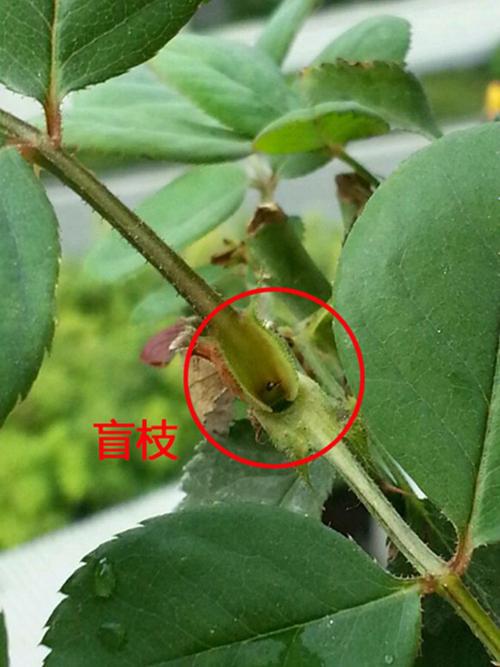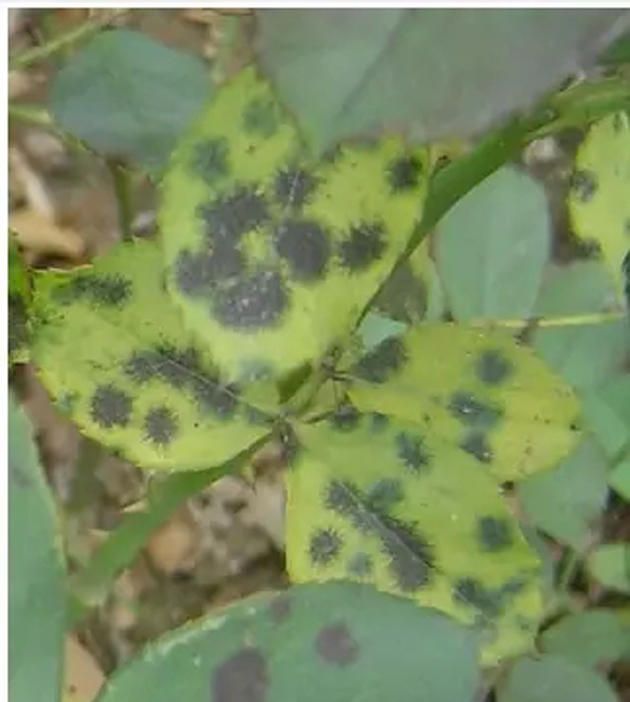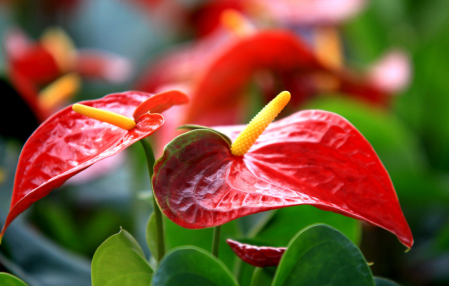Pruning and distinguishing methods of blind branches for the reason why rose does not bloom
Now many people like to breed rose very much, but in the process of cultivating rose, others have blossomed. Why don't their own roses blossom? It turns out that there is a blind branch, how to distinguish the blind branch? How to trim it correctly?
As long as the rose is cultivated properly, it can blossom with branches (note: it is a new branch of the year). The form of flowering is to form a flowering branch from the axillary bud or latent bud point, and then blossom at the top of the branch. so it can be determined that as long as it is rose regardless of variety attributes (micro-month, abundant flowers, hybrid tea, Ouyue, or vines, etc.), as long as there are branches will be able to blossom!
And those branches that cannot blossom, we call them blind branches! These branches no longer differentiate into flower buds and leaf buds, and their growth is stagnant, so they are also called capped branches.
So how to identify the blind branch? The main thing is to see if there are obvious bud bags at the top of the branches.

There are five main reasons for the formation of blind branches:
1. Lack of fat. As we all know, rose is a fertilizer-loving plant, it grows a lot and blossoms, so it is naturally depressed without nutritious supplies.
two。 There is no pruning in winter. The rose can only blossom on the stout branches of the current year, and the rose should be pruned every winter to promote the germination of new flowering branches in the coming year.
3. There is not enough light. The reason is similar to the lack of fertilizer, lack of light synthesis of nutrients, no nutrition to give birth to buds. Light should be more than 6 hours a day to ensure adequate nutritional supply.
4. The temperature is low. In general, blind branches are easy to grow when the temperature is below 12 ℃.
5. Lack of water and soil consolidation
So what should we do when we find the blind branch? Cut it off! After all, we grow rose to enjoy the flowers.
The method of pruning is also very simple, go down along the blind branch, find the fullest bud point, and cut off the upper branch about 1 cm above the bud point.
After the apical dominance is removed, the remaining bud points will sprout new branches.
In addition, water and fertilizer should be strengthened to improve the causes of blind branches.
Of course, if the seedlings are still very small or grow all blind branches, it is recommended to leave blind branches, strengthen the light, water and fertilizer, as long as the nutrition is adequate, these blind branches will sprout one day.
Change the rose flowering season, but did not blossom, it is necessary to have a good look at the rose is a blind branch, quickly get rid of, but also can blossom, rose will grow better.
Pruning of rattan rose in spring
Fujimoto rose is a special type in the large population of modern rose. This type mainly originated from hybrid tea fragrant rose, hybrid Catharanthus roseus, miniature rose, bud mutation of abundant flower rose and bourbon rose, hybrid tea fragrant rose and bourbon rose and so on. Its genetic relationship is close and complex, and it is precisely because of this complexity that it is different in flowering habits, so Fujimoto rose is mainly divided into two types of flowering: first, continuous flowering. That is, it can blossom for 3 or more times continuously in the whole annual growth cycle. Discontinuous flowering, that is, only blossoms once in spring or twice in spring and autumn in the whole annual growth cycle. There is a close relationship between "more and less", "diligence and laziness" and the way of pruning of Fujimoto rose.
Pruning of continuously flowering plants
Taking the plant age of 3 years or more as an example, only two pruning times in spring and autumn were done in the whole annual growth cycle. Spring pruning should only prune dry and withered branches, blind branches and too many bore branches before sprouting. Moderate or heavy pruning should not be carried out blindly without special circumstances, otherwise the amount of flowers in spring will be greatly reduced. According to the maintenance plan of flowering at the end of September or the beginning of lO, considering the difference of air temperature between the south and the north of China, it can be pruned in several different periods, such as early August, late August and early September, and the purpose of flowering at the end of September can be achieved.
Pruning of discontinuous flowering plants
Taking the plant age of 3 years or more as an example, there is only one pruning in spring and before germination in the whole annual growth cycle. If it is not for the rejuvenation of old plants, transplantation or serious diseases and insect pests, only dry and withered branches, blind branches and too many inner bore branches should be trimmed, and moderate or severe pruning should not be done, otherwise, varieties that bloom only in spring and once a year will not blossom in that year, and varieties that only bloom in spring and autumn will only blossom in autumn or even in autumn.
In view of this, the pruning of Fujimoto rose is fastidious, and there are many lessons in this aspect in many years of practice. Professionals should pay attention to the source and technology, and should pay attention to distinguish their flowering habits from the introduction of rattan rose varieties. Try to introduce varieties of Fujimoto rose with high ornamental value and application value, in order to achieve the best landscape effect.
The text on the left: the intensity of pruning is determined by the speed of variety and plant growth. In general, the 3 buds under the cut will become flowering branches. Text on the right (from top to bottom): weak cut (cut off 1x4 of plant height), medium cut (cut off 1amp 2), re-cut (cut off 2max 3).
The system of roses is roughly classified as follows: old rose (Old); hybrid tea-scented rose (HT); abundant flower rose (F); miniature rose (Min); English rose (ER), this time the pruning method of old rose and hybrid tea-scented rose. Pruning methods of HT line (varieties with large flowers in four seasons):
Upper right: HT system. Top left: in the middle of the flowering branch in May last year, look for strong buds facing outward, and cut off the upper part at the 5mm above the bud point. Bottom left: the new shoot shoots that appeared last year are pruned on the first section (the newly pruned branch after flowering) to restrain the overelongation of the branch. Bottom right: the aged branches are trimmed from the base close to the root, and the twigs and dead branches are also cut off.
If you cut off the branches (medium cut and heavy cut) from 1x2 to 2gam3, the number of flowers will decrease in the coming year because there are not many flower buds, but this is a pruning method in line with the system to allow them to produce full and gorgeous flowers.
The pruning method of the old rose:
The upper part: the old Chinese rose system. Bottom left: cut off twigs and dead branches. Lower right: the tip of a strong branch can be slightly cut off (the tip is too thin, the top of the branch with more branches after flowering).
The old rose also needs winter pruning. It is difficult to generalize because of the different tree types, but the amount of pruning is generally less than that of HT, leaving more branches. Cutting too heavily will inhibit the growth of flower buds. The following shows the pruning method of the branches, please take a look at the sketch:
The buds facing the center of the plant type are called inner buds and the outer buds are called outer buds. Pruning is basically carried out in the position of the outer bud. Pruning the position marked with blue lines and the branches growing outward can ensure the ventilation and light of the plant. Pruned with red lines, the branches grow inward and are easy to squeeze together, affecting the ventilation and lighting of the plant.
About the position and angle of branch pruning:
Top left: the correct shearing method, at the upper 5~8mm of the selected strong bud, is parallel to the oblique shear of the bud point. Bottom left: buds that are too close to the bud point will not germinate. Upper right: the trimmed bevel and the bud point are facing opposite. Lower right: the upper part of the bud point is too long, so it is easy to black branch from top to bottom.
The cutting position should be at the 5~8mm above the strong bud, parallel to the oblique shearing of the bud. Please trim the selected buds in the correct way. Be sure to choose a pair of sharp scissors, if the scissors are too blunt, the scissors will break your teeth and easily cause withered branches.
The buds of fullness are as follows:
The buds below are full buds. The buds on the top are too long. Please take a look at the following sketch:
Top left: good buds, unsprouted buds, compact, round and full. Bottom left: buds that have not yet sprouted, cut them here if there are no good buds. Upper right: slender but not compact buds that cannot be expected to produce good flowers. Bottom right: budding buds will also become weak branches. I think this picture is easy to understand.
This is the end of the above explanation on rose winter pruning. Because there are many methods, this article is for reference only. Rose is also different due to different maintenance methods of the system, please note this. I hope your rose will blossom in spring!
- Prev

Identification and control of diseases and insect pests of rose aphids thrips red spiders
Speaking of rose, it is a kind of plant that many people like to breed, and the rose blossoms are also very beautiful, but in the cloudy and rainy season, the diseases and insect pests there are really more than one touch, and the most fatal thing is that they cannot recognize these pests. How to identify these pests and how to control them?
- Next

What about the rotten roots of Anthurium andraeanum? what will happen if there is not enough light?
Anthurium andraeanum is more popular in life, and the flowers are red, which is very auspicious, but how to raise Anthurium andraeanum to have rotten roots, yellow leaves and insufficient light? what can we do? As an indoor potted plant, Anthurium andraeanum is a rare color variety, and its maintenance is relatively simple.
Related
- Fuxing push coffee new agricultural production and marketing class: lack of small-scale processing plants
- Jujube rice field leisure farm deep ploughing Yilan for five years to create a space for organic food and play
- Nongyu Farm-A trial of organic papaya for brave women with advanced technology
- Four points for attention in the prevention and control of diseases and insect pests of edible fungi
- How to add nutrient solution to Edible Fungi
- Is there any good way to control edible fungus mites?
- Open Inoculation Technology of Edible Fungi
- Is there any clever way to use fertilizer for edible fungus in winter?
- What agents are used to kill the pathogens of edible fungi in the mushroom shed?
- Rapid drying of Edible Fungi

